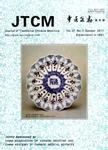Effect of Dongchongxiacao(Cordyceps) therapy on contrast-induced nephropathy in patients with type 2 diabetes and renal insufficiency undergoing coronary angiography
Effect of Dongchongxiacao(Cordyceps) therapy on contrast-induced nephropathy in patients with type 2 diabetes and renal insufficiency undergoing coronary angiography作者机构:Department of CardiologyTianjin Nankai Hospital
出 版 物:《Journal of Traditional Chinese Medicine》 (中医杂志(英文版))
年 卷 期:2015年第35卷第4期
页 面:422-427页
核心收录:
学科分类:1007[医学-药学(可授医学、理学学位)] 100506[医学-中医内科学] 1006[医学-中西医结合] 1005[医学-中医学] 1002[医学-临床医学] 10[医学] 100602[医学-中西医结合临床]
主 题:Cordyceps sinensis Diabetes mellitus Type 2 Coronary angiography Contrast-induced nephropathy
摘 要:OBJECTIVE: To study the protective effects of Dongchongxiacao(Cordyceps)(DCXC) on contrast-induced nephropathy(CIN) in patients with type 2 diabetes and renal insufficiency undergoing coronary ***: A total of 120 patients with type 2 diabetes whose estimated glomerular filtration rate(e GFR) was ≤ 60 m L/minee grou·1.73 m2,were divided randomly into thrps,basic treatment group(n = 41),standard DCXC therapy group(n = 39,2-g corbrin capsules,3 times/d,3 days before and after angiography),and intensive DCXC therapy group(n = 40,3-g corbrin capsules,3 times/d,3 days before and after angiography). Serum creatinine(Scr)and e GFR were assessed at the time of admission to hospital,and on days 1,2 and 3 after angiography. Urine neutrophil-gelatinase-associated-lipocalin(NGAL),kidney injury molecule-1(KIM-1) and interleukin-18(IL-18) were measured before angiography and at day 1 after angiography for all patients. The primary end point was the prevalence of CIN. The secondary end point was a 25% or greater reduction in e ***: CIN occurred in 11 of 120 patients(9.17 %). The prevalence of CIN was lower in the DCXC treatment groups than in the basic treatment group(P 0.05),with a more significant decrease in the prevalence of CIN in the intensive DCXC therapy group(P 0.01). Compared with the basic treatment group,a lower proportion of patients in the DCXC treatment groups had an e GFR decrease of 25% or greater(P 0.05); patients with an e GFR decrease of 25% or greater accounted for an even lower proportion in the intensive DCXC therapy group(P 0.01). Within 1 day of the procedure,urine levels of KIM-1,NGAL and IL-18 in patients in the intensive DCXC therapy group were lower than those in the basic treatment group and standard therapy group(P 0.05).CONCLUSION: DCXC treatment may protect against CIN in patients with type 2 diabetes and renal insufficiency undergoing coronary angiography,with intensive DCXC therapy being more effective.



